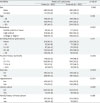1. Jung KW, Won YJ, Oh CM, Kong HJ, Lee DH, Lee KH, et al. Cancer statistics in Korea: incidence, mortality, survival, and prevalence in 2014. Cancer Res Treat. 2017; 49(2):292–305.

2. Jemal A, Siegel R, Ward E, Hao Y, Xu J, Murray T, et al. Cancer statistics, 2008. CA Cancer J Clin. 2008; 58(2):71–96.

3. Dhôte R, Pellicer-Coeuret M, Thiounn N, Debré B, Vidal-Trecan G. Risk factors for adult renal cell carcinoma: a systematic review and implications for prevention. BJU Int. 2000; 86(1):20–27.

4. Henschler D, Vamvakas S, Lammert M, Dekant W, Kraus B, Thomas B, et al. Increased incidence of renal cell tumors in a cohort of cardboard workers exposed to trichloroethene. Arch Toxicol. 1995; 69(5):291–299.

5. Vamvakas S, Brüning T, Thomasson B, Lammert M, Baumüller A, Bolt HM, et al. Renal cell cancer correlated with occupational exposure to trichloroethene. J Cancer Res Clin Oncol. 1998; 124(7):374–382.

6. Brüning T, Pesch B, Wiesenhütter B, Rabstein S, Lammert M, Baumüller A, et al. Renal cell cancer risk and occupational exposure to trichloroethylene: results of a consecutive case-control study in Arnsberg, Germany. Am J Ind Med. 2003; 43(3):274–285.

7. Gandini S, Boniol M, Haukka J, Byrnes G, Cox B, Sneyd MJ, et al. Meta-analysis of observational studies of serum 25-hydroxyvitamin D levels and colorectal, breast and prostate cancer and colorectal adenoma. Int J Cancer. 2011; 128(6):1414–1424.

8. Welsh J. Cellular and molecular effects of vitamin D on carcinogenesis. Arch Biochem Biophys. 2012; 523(1):107–114.

9. Grant WB, Garland CF. Evidence supporting the role of vitamin D in reducing the risk of cancer. J Intern Med. 2002; 252(2):178–179.

10. Grant WB. Ecologic studies of solar UV-B radiation and cancer mortality rates. In : Reichrath J, Friedrich M, Tilgen W, editors. Vitamin D analogs in cancer prevention and therapy. New York: Springer;2003. p. 371–377.
11. Sanders KM, Stuart AL, Williamson EJ, Simpson JA, Kotowicz MA, Young D, et al. Annual high-dose oral vitamin D and falls and fractures in older women: a randomized controlled trial. JAMA. 2010; 303(18):1815–1822.
12. Holick MF. McCollum Award Lecture, 1994: vitamin D--new horizons for the 21st century. Am J Clin Nutr. 1994. 60(4):p. 619–630.

13. Ravenel MP. Rickets including osteomalacia and tetany. Am J Public Health Nations Health. 1930; 20(1):103.

14. Reis JP, von Mühlen D, Miller ER 3rd, Michos ED, Appel LJ. Vitamin D status and cardiometabolic risk factors in the United States adolescent population. Pediatrics. 2009; 124(3):e371–9.

15. Wimalawansa SJ. Vitamin D in the new millennium. Curr Osteoporos Rep. 2012; 10(1):4–15.

16. Jung IK. Prevalence of vitamin D deficiency in Korea: results from KNHANES 2010 to 2011. J Nutr Health. 2013; 46(6):540–551.

17. Ahn KY, Min J, Jeon JY. Association between physical activity and vitamin D in Korean adults: Korean National Health and Nutrition Examination Survey 2009–2013. J Korean Soc Living Environ Syst. 2015; 22(5):712–721.

18. Wacker M, Holick MF. Sunlight and vitamin D: a global perspective for health. Dermatoendocrinol. 2013; 5(1):51–108.
19. Leem JH, Kim HC, Koh DH, Kim SG, Shin MH, Shim YM, et al. Case-control study of occupational exposures with lung cancer, renal cell cancer and hematopoietic cancer. KOSHA OSHRI;2015.
20. Leem JH, Kim HC, Koh DH, Kim SG, Shin MH, Shim YM, et al. Case-control study of occupational exposures with lung cancer, renal cell cancer, and bladder cancer. Ulsan: Korea Occupational Safety and Health Agency, Occupational Safety and Health Research Institute;2016.
21. Boniol M, Koechlin A, Boniol M, Valentini F, Chignol MC, Doré JF, et al. Occupational UV exposure in French outdoor workers. J Occup Environ Med. 2015; 57(3):315–320.

22. Karami S, Boffetta P, Stewart P, Rothman N, Hunting KL, Dosemeci M, et al. Occupational sunlight exposure and risk of renal cell carcinoma. Cancer. 2010; 116(8):2001–2010.

23. Boscoe FP, Schymura MJ. Solar ultraviolet-B exposure and cancer incidence and mortality in the United States, 1993–2002. BMC Cancer. 2006; 6(1):264.

24. Mohr SB, Gorham ED, Garland CF, Grant WB, Garland FC. Are low ultraviolet B and high animal protein intake associated with risk of renal cancer? Int J Cancer. 2006; 119(11):2705–2709.

25. Alagöl F, Shihadeh Y, Boztepe H, Tanakol R, Yarman S, Azizlerli H, et al. Sunlight exposure and vitamin D deficiency in Turkish women. J Endocrinol Invest. 2000; 23(3):173–177.

26. Lips P. Vitamin D physiology. Prog Biophys Mol Biol. 2006; 92(1):4–8.

27. Wolff AE, Jones AN, Hansen KE. Vitamin D and musculoskeletal health. Nat Clin Pract Rheumatol. 2008; 4(11):580–588.

28. Bikle D. Nonclassic actions of vitamin D. J Clin Endocrinol Metab. 2009; 94(1):26–34.

29. Holick MF. Vitamin D deficiency. N Engl J Med. 2007; 357(3):266–281.

30. Holick MF. High prevalence of vitamin D inadequacy and implications for health. Mayo Clin Proc. 2006. 81(3):p. 353–373.









 PDF
PDF Citation
Citation Print
Print



 XML Download
XML Download